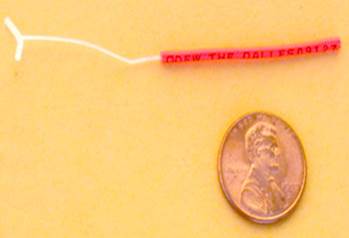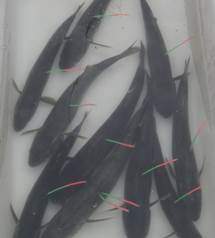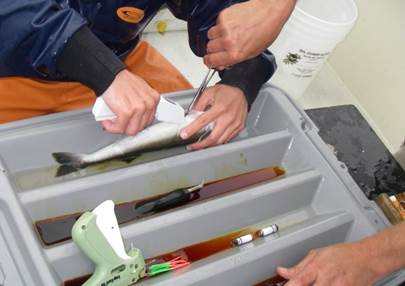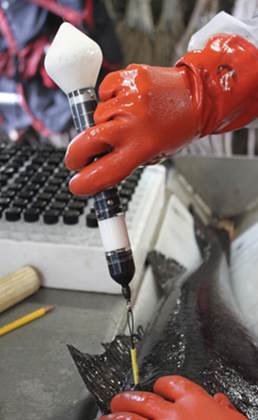Welcome to the AFSC Groundfish Tagging application.
Quick Tips:
- Use the tabs to toggle between different data visualizations.
- Use the forms to change search criteria to find the data you desire.
- Use Shift + Click + Drag to zoom to specific location on the maps.

Legend
The National Marine Fisheries Service (NMFS) has been tagging and releasing groundfish in Alaska waters since 1972. In that time, approximately 467,000 tags have been released and over 36,000 have been recovered. Tagging effort in Alaska has primarily occurred on the AFSC annual longline survey, with additional tagging cruises occurring in inside southeast Alaska waters, Gulf of Alaska seamounts, and various bays throughout the Gulf of Alaska.
Data:
Tag release and recovery data are stored in the NMFS Alaska Tag Database. Analysis of tag data is the primary method used to study movement. The results show that some species (e.g., sablefish) are highly migratory for at least part of their lives, and their movement rates are great enough to affect the amount of fish available for harvest in an area, and that others (e.g., shortspine thornyhead) show very little movement. Tag data have been used to validate otolith aging, conduct growth studies, and to help determine the age of recruitment into the fishery.
Tagged Species
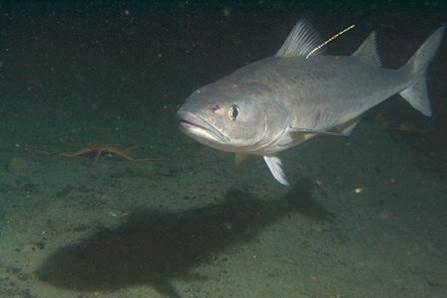
Tagged adult sablefish with an external T-bar anchor tag.
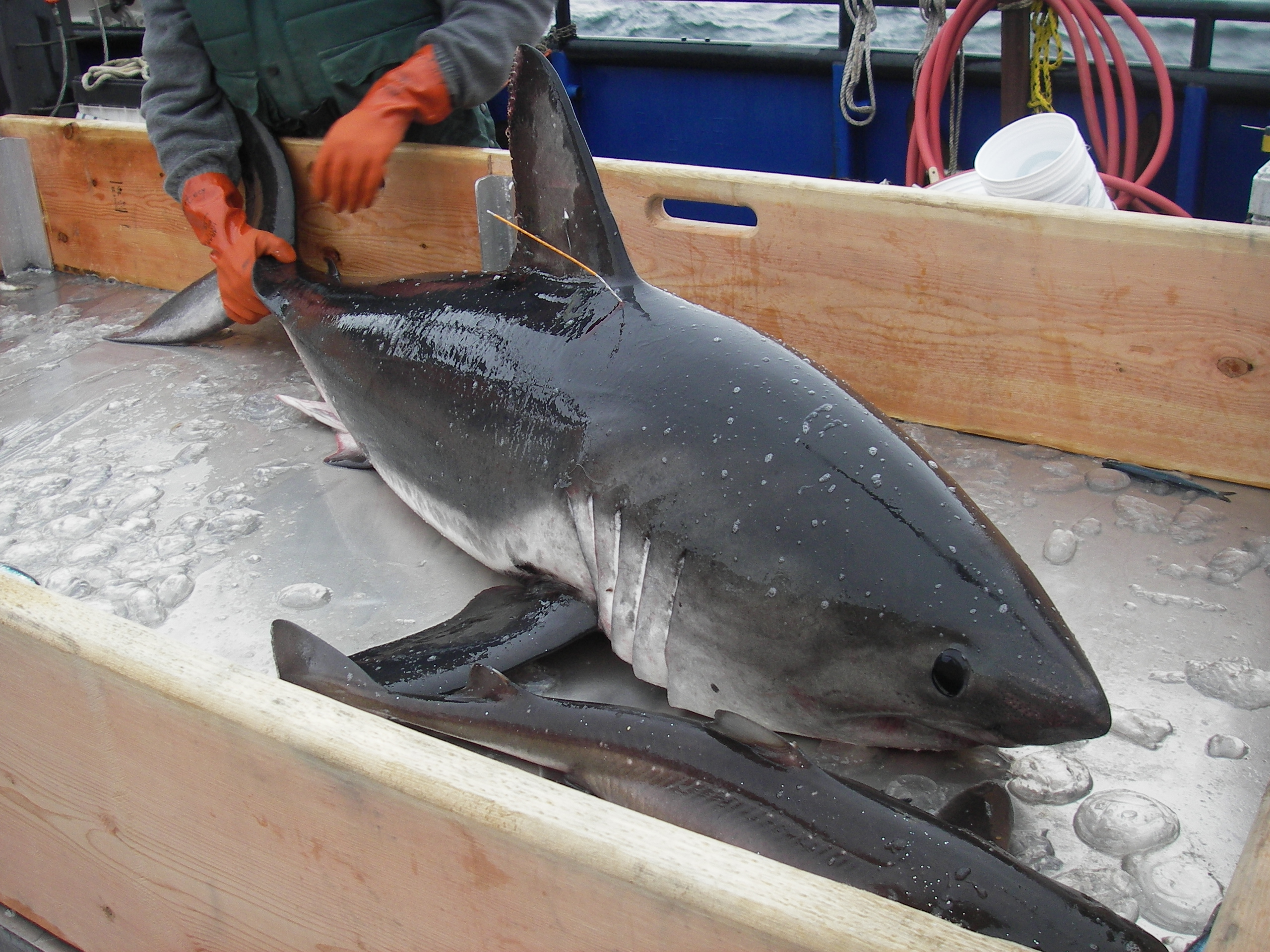
Tagged salmon shark with external tag.

Tagged spiny dogfish with a pop-off satellite tag.
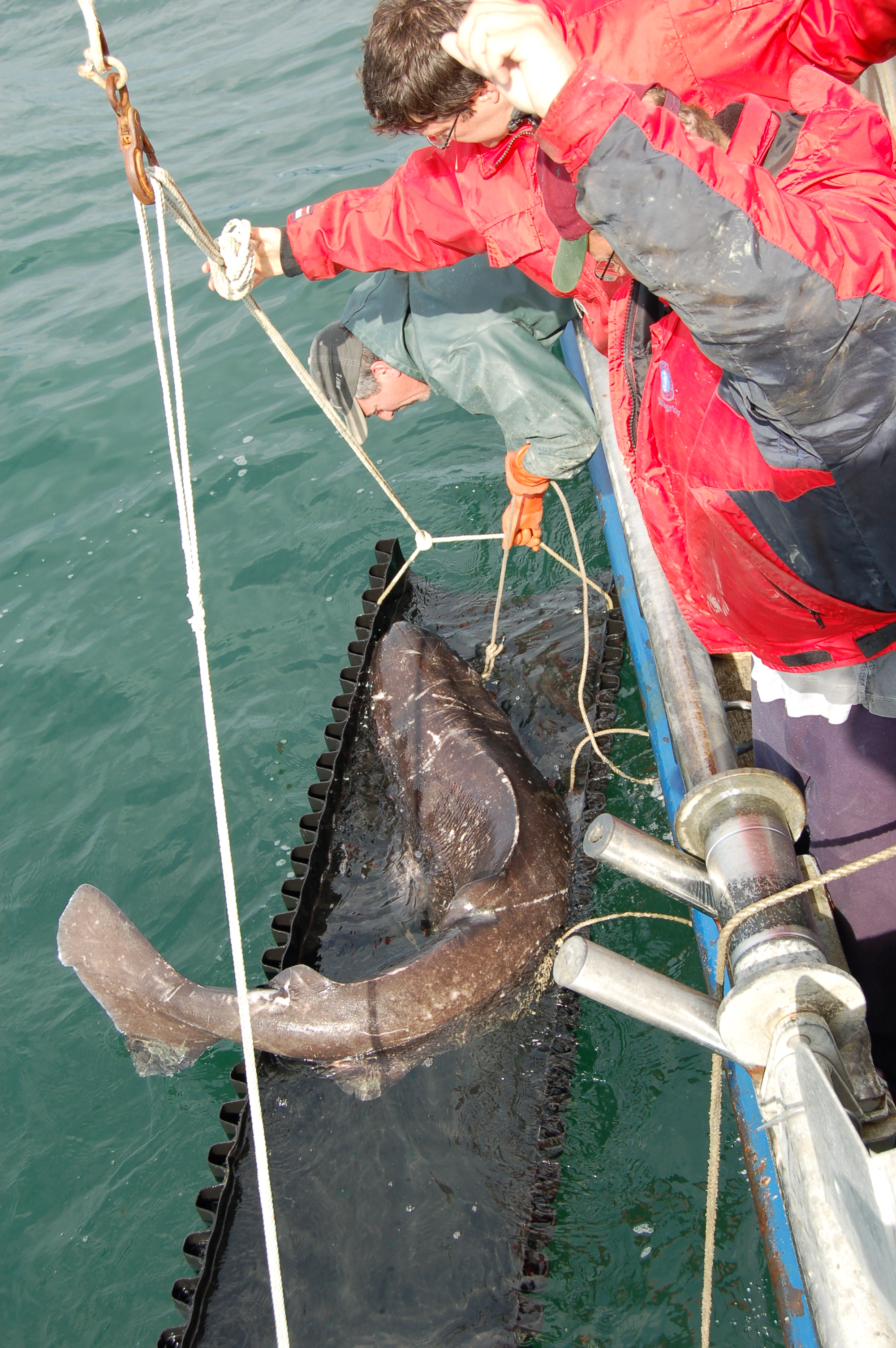
Pacific sleeper shark being tagged with a pop-off satellite tag.
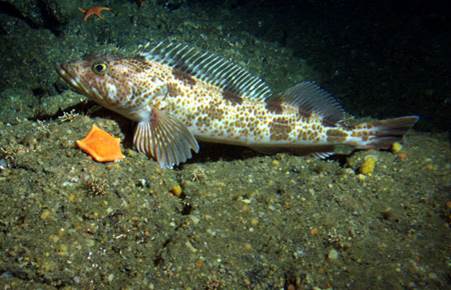
Lingcod in the wild.

Rougheye rockfish in wild.
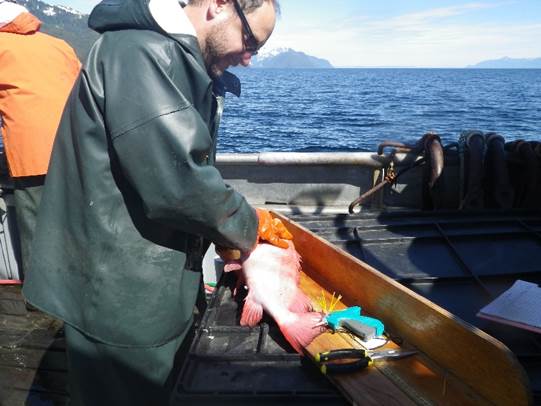
AFSC scientist, Pat Malecha, tagging a rougheye rockfish with an external T-bar anchor tag.

Tagged Greenland turbot with an external spaghetti tag.

AFSC scientist, Dr. Dana Hanselman, with a tagged Greenland turbot on the AFSC longline survey.
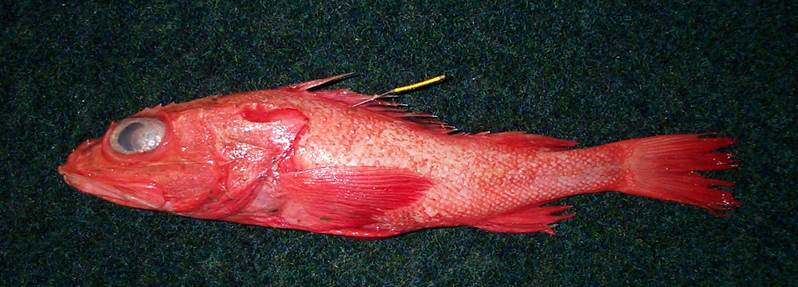
Shortspine thornyhead with an external T-bar anchor tag.

AFSC scientists, Drs. Cindy Tribuzio and Kalei Shotwell, surgically inserting an electronic archival tag into the abdomen of a lingcod on the AFSC longline survey.
Sablefish - as juveniles and adults
Sablefish are tagged as juveniles (age-1) in nearshore shallow bays (predominately in inside southeast Alaska waters) with both external T-bar anchor tags and internally placed archival tags. Juvenile sablefish tagging helps track ontogenetic migration into deeper waters of the slope and determine the age of recruitment into the fishery.
Adult sablefish are tagged each year on the AFSC annual longline survey. Current and past tag types used have included external T-bar anchor tags, internal archival tags, and external pop-off satellite tags. Approximately 5% of the sablefish caught on the annual longline survey are tagged. Tagging data of sablefish have been used to validate otolith aging, conduct growth studies, study movement, help determine the age of recruitment into the fishery, determine spawning practices and locations, and assist with allocating geographic apportionment of harvest.
For more information please contact Katy Echave, katy.echave@noaa.gov.
Salmon Sharks
Salmon sharks were tagged during targeted research surveys conducted in Prince William Sound with pop-off satellite tags and GPS tracking tags from 1990 - 2001. Results of that study contributed to understanding seasonal foraging movement of the species.
For more information please contact Cindy Tribuzio, cindy.tribuzio@noaa.gov.
Spiny Dogfish
Spiny dogfish have been tagged with Peterson disk tags, surgical implanted archival data storage tags and pop-off satellite tags since 2004. The pop-off satellite tagging began in 2009. Results are showing that this species is highly migratory, with tag recoveries from Japan, Russia and Southern California; and that they spend a great deal of time in near surface waters, even when over great depths.
For more information please contact Cindy Tribuzio, cindy.tribuzio@noaa.gov.
Pacific Sleeper Sharks
Pacific sleeper sharks have been tagged with pop-off satellite tags, acoustic tracking tags and archival data storage tags, as well as conventional tags since 2001. Sharks were tagged near seal rookeries to examine potential predator/prey interactions as well as habitat use. All tagged fish have been juveniles, and one tag was recovered < 1 km from the release location after eight years.
For more information please contact Cindy Tribuzio, cindy.tribuzio@noaa.gov.
Lingcod
Lingcod were tagged opportunistically on the AFSC annual longline survey from 2007 to 2010 with internal archival tags and pop-off satellite tags. Movement of lingcod was previously unknown, and tag data helped determine if lingcod exhibit directed movement for spawning purposes, and to where.
For more information please contact Katy Echave, katy.echave@noaa.gov.
Rougheye/Blackspotted Rockfish
Rougheye and blackspotted rockfish have been tagged to study their survival and movement after capture. The rockfish family, Sebastes, are not able to release rapidly expanding gas from their swim bladder during capture, resulting in injuries. It has been assumed that these fish die after capture and release, but tagging efforts have shown that they can survive these injuries. This opens the possibility of utilizing tags to follow rockfish movement on a larger geographical and time scale.
For more information please contact Cara Rodgveller, cara.rodgveller@noaa.gov.
Greenland Turbot
Greenland turbot have been tagged on the annual AFSC longline survey in the Aleutian Islands and Bering Sea since 1997 with external spaghetti tags and internal archival tags. Tagging data has helped determine seasonal movement patterns and changes in behavior during times of spawning.
For more information please contact Katy Echave, katy.echave@noaa.gov.
Shortspine Thornyhead
Shortpsine thornyhead have been tagged on the annual AFSC longline survey since 1997 with external T-bar anchor tags and internal archival tags. Shortpsine thornyhead are unlike other Sebastolobus species, in that they don't possess a swim bladder, making them ideal tagging specimens. Tagging data has revealed information on movement or lack of, as well as assisted in stock structure analysis.
For more information please contact Katy Echave, katy.echave@noaa.gov.
AFSC Longline Survey: Watch the Video
The National Marine Fisheries Service (NMFS) has been tagging and releasing groundfish in Alaska waters since 1972. In that time, approximately 430,000 tags have been released and over 36,000 have been recovered. Tagging effort in Alaska has primarily occurred on the AFSC annual longline survey, with additional tagging cruises occurring in inside southeast Alaska waters, Gulf of Alaska seamounts, and various bays throughout the Gulf of Alaska. Please watch the video below for more information on the longline survey where tagging occurs.
Tags used include: external T-bar anchor and spaghetti tags, external Pedersen disc tags, internally placed electronic archival tags, and external pop-off satellite tags.
T-bar Anchor and Pedersen Disc tags
The most commonly used tag type, generally located below the dorsal fin on the left side of the fish. Found on tagged sablefish, shortspine thornyhead, rougheye rockfish, Greenland turbot, spiny dogfish, salmon shark, and Pacific sleeper shark.
Electronic Archival Tags
Electronic archival tags are tags that collect temperature and depth data at a predefined sampling interval for the life span of the tag. They are placed internally, with an external T-bar anchor tag alerting the recipient of the internal tag. Found on tagged sablefish, shortspine thornyhead, and Greenland turbot.
Pop-off Satellite Tags
Pop-off satellite tags (PSATs) are externally attached and collect depth, temperature, acceleration, light, and geomagnetic data at a predefined sampling interval. They are programmed to release from the fish on a specified date, and after surfacing, data is acquired by passing satellites and passed on to the scientist. These are the only fishery independent tags in use. Sablefish, spiny dogfish, and rougheye rockfish have been tagged with PSATs.
Primer for archival tag data processing using R
Coutré, K. M. 2017. Primer for archival tag data processing using R. AFSC Processed Rep. 2017-01, 21 p. Alaska Fish. Sci. Cent., NOAA, Natl. Mar. Fish. Serv., 7600 Sand Point Way NE, Seattle WA 98115.
First results of the tagging of shortspine thornyhead, Sebastolobus alascanus, in Alaska
Echave, K. B. 2017. First results of the tagging of shortspine thornyhead, Sebastolobus alascanus, in Alaska. Fish. Res. 195: 46-51.
Feasibility of tagging sablefish, Anoplopoma fimbria, with pop-off satellite tags in the northeast Pacific Ocean
Echave, K. B. 2016. Feasibility of tagging sablefish, Anoplopoma fimbria, with pop-off satellite tags in the northeast Pacific Ocean. U.S. Dep. Commer., NOAA Tech. Memo. NMFS-AFSC-320, 38 p. (.pdf, 1.5 MB).
Move it or lose it: Movement and mortality of sablefish tagged in Alaska
Hanselman, D.H., J. Heifetz, K.B. Echave, and S.C. Dressel. 2015. Move it or lose it: Movement and mortality of sablefish tagged in Alaska. Can. J. Fish. Aquat. Sci. 72(2): 238-25.
Report to Industry on the Alaska Sablefish Tag Program, 1972-2012
Echave, K., D. H. Hanselman, and N. E. Maloney. 2013. Report to Industry on the Alaska Sablefish Tag Program, 1972-2012. U. S. Dep. Commer., NOAA Tech. Memo. NMFS-AFSC-254, 47 p.
Age-specific movement patterns of sablefish (Anoplopoma fimbria) in Alaska
Maloney, N.E. and M.F. Sigler. 2008. Age- specific movement patterns of sablefish (Anoplopoma fimbria) in Alaska. Fish. Bull. 106:305-316 (2008).
Depth and movement behavior of the Pacific sleeper shark in the north-east Pacific Ocean
Hulbert, L., M. Sigler, and C. R. Lunsford. 2006. Depth and movement behavior of the Pacific sleeper shark in the north-east Pacific Ocean. J. of Fish Biol. 69:406-425.
Seasonal foraging behavior and migratory patterns of female lamna ditropis tagged in Prince William Sound, Alaska
Hulbert, L., A. M. Aires-Da-Silva, V. F. Gallucci, and J. S. Rice. 2005. Seasonal foraging behavior and migratory patterns of female lamna ditropis tagged in Prince William Sound, Alaska. J. Fish Biol. 67:490-509.
Sablefish, Anoplopoma fimbria, populations on Gulf of Alaska seamounts
Maloney NE. 2004. Sablefish, Anoplopoma fimbria, populations on Gulf of Alaska seamounts. Mar. Fish. Rev. 66: 1-12.
Estimation of tag-reporting rates for sablefish in the northeastern Pacific Ocean
Heifetz J, Maloney NE. 2001. Estimation of tag-reporting rates for sablefish in the northeastern Pacific Ocean. Alaska Fish. Res. Bull. 8: 1-11.
Movement dynamics of tagged sablefish in the northeastern Pacific
Heifetz J, Fujioka JT. 1991. Movement dynamics of tagged sablefish in the northeastern Pacific. Fish. Res. 11: 355-374.
Contact
Katy Echave
Auke Bay Laboratories
Alaska Fisheries Science Center, NOAA Fisheries
Ted Stevens Marine Research Institute
17109 Pt Lena Loop Rd
Juneau AK 99801
